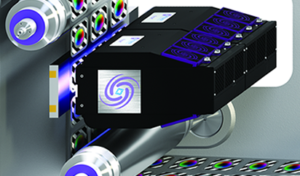From interdeck pinning to drying full-colour digitally printed sheets, there’s a technology out there to suit your application.
Given the work that is going into advancing inks and toners, it is no surprise to find out that those involved in drying and curing such chemistries and solutions are likewise investing heavily into the future of their technologies. An example put forward by Phoseon is the expansion of low migration inks, with the popularity of low migration UV LED curable inks driving the need to develop and introduce technologies that can deliver benefits such as enhanced food-safety and a more stable print process with greater control in crosslinking inks, coatings and adhesives. The rise of UV LED further facilitates continued expansion of the substrate range. More specifically, UV LED technology allows users to cure a variety of heat-sensitive substrates that have previously been unusable with traditional UV arc lamps.
This, in turn, necessitates deep and meaningful collaboration across the supply chain to deliver functional and appropriate technologies.
Stacy Hoge, marketing communications manager at Phoseon, explains, ‘We have a systems approach that requires collaboration from the ink company, OEM and LED curing lamp supplier. We make sure that we stay involved with all the latest technology. All major ink suppliers have our lamps in their labs so most of the testing of inks and materials are done with Phoseon products. Phoseon also is involved with raw material suppliers to the ink industry as they further develop supporting components for LED inks, coatings and adhesives.’
Another driver identified by Phoseon is that of digital/flexo integration in set-ups that leverage the benefits of both technologies. By combining two production tools in virtually the same footprint, it is ideal to have associated technologies installed on the press that easily support both processes, offering one technology for the whole print flow.
More generally, higher press speeds and wider widths feature highly in the development of drying and curing systems. ‘Due to increased press speeds, more power is required from the UV curing light source, as having enough power is crucial to the curing process,’ explains Ms Hoge. ‘This is where peak irradiance and energy density (dose) come in to play. A minimum threshold of irradiance is needed to start the polymerisation process, and then a dwell time of dose is needed to finish the curing process. Both high irradiance and energy density are required for a successful cure.’
Phoseon offers both air-cooled and water-cooled UV LED curing options, from small compact pinning to high powerful systems for full cure. Specifically, FireJet FJ240 and FireLine FL440, air- and water-cooled options respectively, are systems suited for single-pass inkjet applications. Single-pass inkjet printing is a process being advanced for a number of applications, not least packaging in its many forms.. From sheet-fed corrugated to web-fed flexible packaging presses, the evolution of inkjet keeps progressing.
Tags: UV LED Technology | UV LED Industrial Curing | UV LED Curing Systems | UV LED Curing | Digital Labels & Packaging MagazineCategories: Inks | Printing, Digital | Printing, Flexo
